Martial arts, for the most part, is not a new concept. The human species has spent an innumerable amount of time over the course of its existence trying to codify and improve upon methods for both causing and preventing harm to other human beings.
Interestingly, though, even at one of the greatest times of peace in our modern age (or, gunpowder and technology-driven violence, as it were), there are still new terms and styles evolving every day. A somewhat mysterious and often unheard-of term that has begun to circulate in the last twenty years is now gaining a serious foothold in martial arts as a whole during the 21st century. That term is HEMA.
HEMA stands for Historical European Martial Arts. While mostly self-explanatory, HEMA encompasses the study and application of martial practices of or relating to European cultures. Why does this stand out from martial arts enough to warrant its own special alphabet-soup-style name?
When martial arts was first mentioned in this article, what did you picture in your head? Two 15th Century German gentlemen settling a judicial dispute, wielding swords on either side of enormous, 6′ tall standing shields? Probably not.
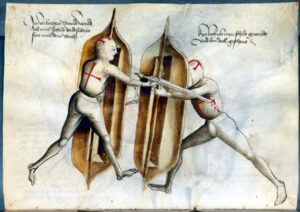
Seriously, canoes are a totally valid off-hand weapon in Germany. They also invented bodystockings. Who knew?
You probably pictured ninjas. At the very least, a couple of people in white gis doing high kicks. As both pop culture and the common assumption would have you believe, martial arts involves a special method of fighting that originates in some far Eastern land. It also may involve punching waterfalls and a series of progressively more interesting headbands if you grew up watching Hong Kong kung-fu films from the 70’s like I did. Neither of these things is true.
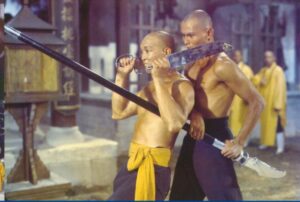
I know this is from “36th Chamber of Shaolin”, but I have no idea what is happening in this moment and both of them look very concerned.
For whatever reason, “martial arts” in America became synonymous with traditional Eastern styles like “kung fu” (as we frequently describe a group of over 30 individual Chinese styles), Karate, Judo, Muay Thai, and others. These are all incredible arts with a long-standing traditional pedigree and a host of fluent practitioners – but wait. We know that combat and warfare existed outside of Asia, right? What happened to those styles? Those arts?
That’s exactly the question that HEMA is poised to answer. The study (and resurgence) of Historical European Martial Arts (also referred to as Western Martial Arts in a broader sense, we’ll get there later) accomplishes several goals simultaneously. There is a gap that has existed in martial history for a long time, spanning all the way back to Classical Antiquity, and the western obsession with Eastern martial culture and mysticism almost extinguished the chances of closing it. HEMA practitioners seek to reinvigorate both the cultural and practical importance of European martial traditions including swordsmanship, unarmed combat, dueling, and a variety of other techniques and styles.
Thanks to a dedicated group of researchers in the 1980s and 90s, as well as the rise of the internet and digital mass communication, the age of the digital HEMA restoration is upon us. The original source work written by European swordmasters is now available almost entirely online and in print, with the earliest recorded specifically martial treatises dating as far back as the 1300s. These aren’t just paintings or interpretations, either – these are legitimate treatises, pamphlets and books on how to do this! Where the Eastern martial arts relied on the tradition of passing knowledge from master to student orally, it seems their Western peers almost saw the decline of their traditions on the horizon. That, or they just started using marketing brochures and business cards sooner – either way, we’re happy to have the source material.
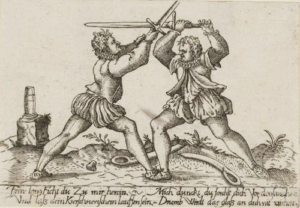
“Come, join us at the best martial arts school ever! First month free! Get your duels won faster! Short pants encouraged!” Marketing is weird.
So, what makes the Eastern and Western schools different? Well, there is the obvious and highly vague answer – culture. The priorities and goals of the medieval and renaissance Europeans were vastly different at times from their Asian counterparts. The demands of combat involved not only differing mindsets (such as the right to settle disputes through duels vs the ability of a samurai to remove the head of any below him for not showing respect), but also the differing restrictions of technology. Metallurgy evolved independently around the world, and as such so did the techniques for forging weapons and armor. This is incredibly obvious at first glance with Archery. Materials for the construction of projectile weapons (including the best wood for a bow available) seriously influenced the development of both the English Longbow and the Japanese Yumi. The availability of resources, additionally, influenced the development of these martial arts. The sheer value of a suit of armor in the weight of steel used to produce it, let alone the workmanship, created a distinct divide between Eastern and Western styles of armor.
“Great, so they’re different. Europe and Asia are different. So what?”
The evolution of HEMA and the development of a respectable and active community around it has made it possible for most people today to learn a style of martial arts that seemed like a fantasy for most of their lives – longsword, spear, rapier, etc. These are likely available in your local city right now. In 2016. That’s just… cool. It’s not all just funny clothes and reenactors anymore, either. The clubs are meeting and using modern, athletically-oriented equipment to simulate the arts as best as they can with all the advances in safety that modern materials allow. Synthetic swords and lightweight armor to simulate fighting in no armor at all are very common in the longsword community.
Why get involved with HEMA, then? Will you be carrying around a sword and buckler for self-defense very often? Not likely. It’s important to consider, though, that the human body hasn’t changed very much physically in thousands of years. The people who developed both Eastern and Western martial arts were perfecting ways for one human body to cause the most damage possible to another human body, and many are surprised to find out they came to the same conclusions. In a German grappling book from the 1600s, we see many of the same principals of physics for moving another human as are found in modern Judo takedowns. The important thing to remember is that there are only so many ways the human body bends and moves, and only so many ways to take advantage of that. A large point of exploring the Western side of Martial Arts is to have the benefit of the culmination of hundreds of years of research that these instructors and practitioners did to find the best possible way to do these things, so we can stop trying to reinvent the wheel on how to fight like a European.
The culmination of application, then, results in a few different things. As I mentioned before, you may not have the fashionable style required to pull off a sword on your hip all the time, but the self-defense applications of grappling, striking, wrestling, and general spatial awareness are as present in HEMA/WMA as they are in any martial art.
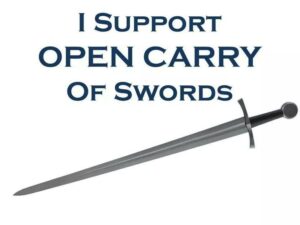
So do we, internet. So do we.
In addition to the practical application, there is an incredible martial heritage that was very close to being lost and is in desperate need of preservation. It’s an important part of the history of not only Europe but other “Western” cultures as well. While mentioned briefly earlier, to extrapolate – Western Martial Arts is a derivative term often used that not only includes the HEMA, but also martial arts of the indigenous American cultures (who have a richly combative history, among other things), and Siberian and Middle Eastern historical martial arts as well.
It’s impressive to think in America that there are thousands of years of Native American martial traditions, and then hundreds of years of European martial traditions layered on and mixed with them, that were all but abandoned as the mysticism of the East became the newest fashion. Incorporating the martial traditions from all over the world and continuing the pursuit of new skills and impossibly perfect execution – this is the real goal of any martial artist. With the development of HEMA groups around the U.S. and the world, as well as the prevalence of events such as CombatCon, Longpoint, and others, it’s easier than ever to get started in the arts.
Additionally, HEMA plays an important role for stage combatants and actors. Swordfights and action scenes have garnered a place of respect among filmmakers and theatrical producers alike – they hold the attention of the modern-day instant gratification audience. To understand and be inside of those things, many actors and stunt performers have turned to real martial arts of many varieties, and HEMA provides a way to be in the closest possible facsimile of a “real” sword fight. Why does the fight not end immediately? How skilled are these two opponents? Does someone make a mistake? All of these are very real scenarios, but don’t become real until an actor experiences and breaks through the adrenaline threshold of simulated combat.
Martial arts of all kinds teach discipline, respect, loyalty, and character – western martial arts are no different. Cultivating the mind and body simultaneously is an important part of being human. While some kids grew up wanting to be a ninja, I grew up wanting to be a knight – thankfully, there’s never been a better time to be training as a knight than right now.
No, seriously. It’s like the 15th century but with running water and smartphones, and without the plague. What are you waiting for?
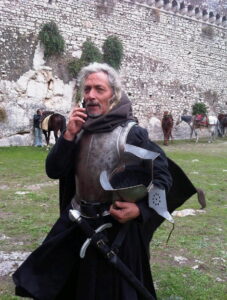
“Yeah honey, I paid the electric. I’ll let you know how our family’s honor and landholdings stand soon. Loving HEMA. Text me later.”
